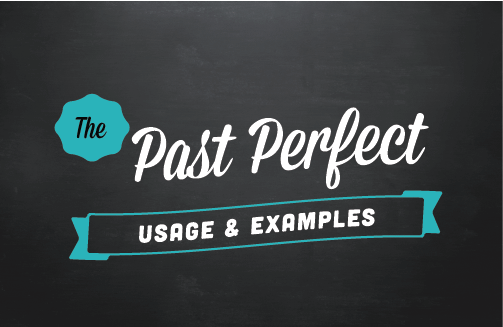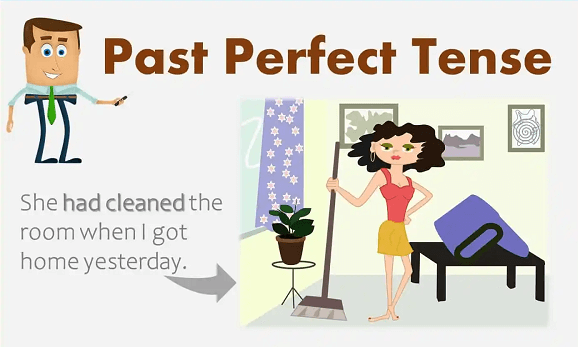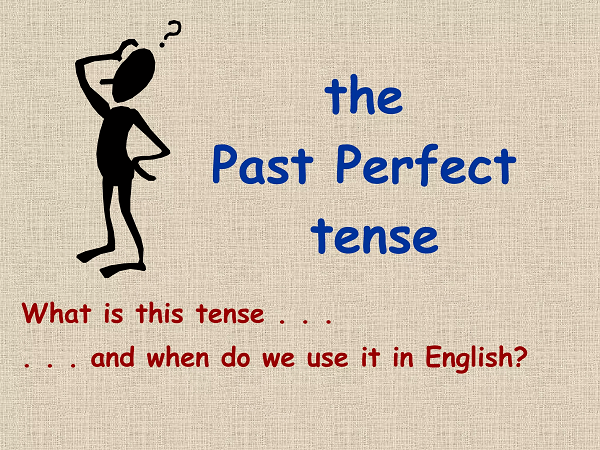Past Perfect Tense DefinitionThe past perfect tense describes completed activities before another event or point. It is frequently used to denote that one action was completed before another started. The past participle of the main verb is placed after the auxiliary word "had" to create the past perfect tense in English. 
For instance, the past perfect tense ("had eaten") is used to indicate that the action of eating breakfast was finished before the action of going to work occurred in the sentence "I had eaten breakfast before I went to work." The past perfect tense is frequently employed when presenting stories and when it's crucial to establish a precise order of occurrences. Speakers and writers can more accurately describe the time of events and establish a feeling of development or continuity by employing the past perfect tense. Formation of the Past Perfect TensesThe auxiliary word "had" is used with the past tense of the main verb to create the past perfect tense. The following is the formula for creating the past perfect tense: Subject + had + main verb's past tense. Here are a few instances:
Remember that normal verbs form their past tense by adding the suffix "-ed" to their basic form. (e.g., "walked", "talked", "played"). However, irregular verbs require memorization because they have several past participle forms. (e.g., "gone", "written", "taken"). Also acceptable in the past perfect tense are contractions like "I'd" for "I had" and "hadn't" for "had not." However, in other situations, contractions could be seen as informal. Using the Past Perfect Tense to Show Completed ActionsThe past perfect tense is frequently used to indicate that one activity was finished before another past event or point. This makes it easier to express an accurate timeline of events and the timing of activities. Here are a few instances:
The past perfect tense is used in these sentences to indicate that the first action (learning French, leaving the party, and completing the report) was finished before the second action (relocating to Paris, attending the party, and meeting the deadline) took place. When explaining previous occurrences, the past perfect tense can also aid in preventing ambiguity or misinterpretation. Take the phrase "He had lost his phone," for instance. It is still determined whether he lost his phone before or after the other events being recounted without the past perfect tense. By utilizing the past perfect tense, we can clarify that the phone was lost before the other occurrences. Using the Past Perfect Tense to Show a Series of Previous OccurrencesWhen there are several previous actions or events, the past perfect tense is particularly helpful for describing how they happened in order. Speaking and writing in the past perfect tense makes it easy to distinguish between what happened first and what happened later. Here are a few instances:
The past perfect tense is used in each of these sentences to indicate an action or event that happened before another action or event that already happened in the past. This makes building a precise timeline of events easier and gives the reader or listener an idea of how things developed in the past. It should be noted that when describing a series of past occurrences, the past perfect tense is not always required, especially if the context makes the order of the events evident. However, adopting the past perfect tense can be beneficial for clarity when the order of events is unclear or confusing. The Past Perfect's Distinctions from Other Past TensesOne of numerous past tenses in English, the past perfect tense, requires understanding the distinctions between them to be used correctly. The past perfect tense and other past tenses have the following main distinctions: Past Simple TenseThe simple past tense represents acts that have already been accomplished in the past, although it does not always imply a chain of events. Simply reporting what happened in the past is how it is frequently utilized. For illustration: "I ate breakfast this morning." Past Continuous TenseThe past continuous tense discusses ongoing acts at a particular point. It doesn't say whether or whether the action was successful. For instance: "She called me while I was eating breakfast." Past Perfect Continuous Tense
The past perfect continuous tense discusses ongoing activities before another past activity or point in time. While it emphasizes the length of the action, it is similar to the past perfect tense. For instance: "I spent hours studying before I finally grasped the idea." On the other hand, the past perfect tense is used exclusively to talk about past actions that were finished before another past event or point in time. It emphasizes the timing of prior activities and establishes a distinct timeline of occurrences. You can speak more clearly and properly when explaining past events if you know the distinctions between these past tenses. Common Errors with the Past Perfect Tense to AvoidThe following slip-ups are typical ones to avoid when using the past perfect tense: When to Use the Past Perfect Tense It's vital to employ the past perfect tense only when it's necessary to portray a certain meaning or sequence of previous occurrences. Using it might prevent your work or speech from sounding artificial or muddled. Mistaking the Simple Past Tense for the Past Perfect Tense The simple past tense represents previous activities that have been accomplished but do not always imply a chain of events. When you want to say that an action was finished before another past action or point in time, you must use the past perfect tense. Using the Past Perfect Tense with Specific Time Expressions The past perfect tense is frequently used with broad time expressions like "before," "after," "already," and "never," as well as other time-related terms. It can be confusing or unnecessary to use it with particular time expressions like "yesterday" or "last week." Using the Past Perfect Tense in Hypothetical Statements When the hypothetical situation did not occur, the past perfect tense is not used. The past perfect subjunctive or past perfect conditional should be used in these situations. Misuse of the Past Participle 
The past perfect tense is created by combining the main verb's past participle with the auxiliary word "had." If you want to ensure your writing and speaking are correct, use the appropriate past participle form. You may skilfully utilize the past perfect tense and convey past events more clearly by avoiding these typical blunders. Contextual Illustrations of the Past Perfect TenseHere are some context-relevant instances of the past perfect tense: 1. I had finished my homework before turning it in for the night. The past perfect tense is used to demonstrate that the action of finishing the homework came before the activity of going to bed in this line. 2. She had already finished her breakfast when I got there. The past perfect tense is employed in this sentence to indicate that eating breakfast was done before coming. 3. They had never been to Europe until last year. The past perfect tense is used in this illustration to demonstrate that the activity of traveling to Europe had never happened before last year. 4. Everyone had already departed the party by the time I arrived. Here, the action of leaving the party was finished before the activity of coming, as shown by the use of the past perfect tense. 5. He had been studying for months before the exam. The past perfect continuous tense is used in this sentence to indicate how long the action of studying for the exam lasted. 6. If I had been aware of the traffic, I would have departed sooner. Here, a hypothetical circumstance that didn't happen in the past is expressed using the past perfect subjunctive. The past perfect tense is generally helpful for portraying hypothetical events that did not occur and the timing and order of completed past acts. Using Time Expressions and the Past Perfect TenseTime expressions can be employed with the past perfect tense to put an action or event that happened before another previous event in context. The past perfect tense can be used with the following common temporal expressions: By the Time This phrase suggests that one historical event was finished before another. For instance, " By the time I got home, my mom had already cooked dinner. " Already This phrase shows that something occurred earlier than a particular historical moment. For instance: "I had already seen that film before a friend told me about it." Before This word shows something earlier than a particular historical event. As an illustration, say, "I finished my homework before I went to bed." Just This phrase is used to say that one occurrence happened right before another one in the past. For instance: " I had just arrived at the airport when my flight was cancelled." It's crucial to remember that time expressions are employed to offer more details regarding the timing of activities in connection to one another. Although they are not necessary when employing the past perfect tense, they might clarify the sense of the statement. Examples:
The Past Perfect Tense in Reported SpeechIn reported speech, the past perfect tense can also represent an activity that occurred before the past event was reported. When employing the past perfect tense in reported speech, it is important to keep the opening sentence or verb's tense in the past tense while changing the tense of the reported speech to the past perfect. Here are a few instances: Direct Speech I had finished my task before leaving the workplace. Reported Speech She reportedly stated that she had completed her task before leaving the workplace. Direct Speech By the time our friends arrived, we had already finished dinner. Reported Speech They said their companions had already finished their dinner by the time their companions arrived. Direct Speech He read the book before the movie to use his own words. Reported Speech She reportedly said he had read the book before the movie. 
When writing reported speech, it's crucial to maintain the original sentence's meaning and tense while making any required adjustments to account for the reporter's changing point of view. Storytelling with the Past Perfect TenseWhen describing a story, the past perfect tense can be used to explain things that happened in the past before the story's main events. The following advice will help you use the past perfect tense when writing stories:
Here is an illustration of a narrative in the past perfect tense: "After several hours of hiking, I finally found a tiny brook. I paused to rest and drank some of the stream's water. I discovered that I had misplaced my map while taking a nap. It was nowhere to be located despite my best efforts to look through my bag. I must have dropped it without realizing it because I was preoccupied with the trail. I decided to go back to see if I could locate the map. After approximately an hour of trekking, I heard rustling in the underbrush. I approached with caution and noticed a deer drinking from a nearby stream. The deer finished its drink, and I watched silently as it headed back into the woods. I became aware that I was lost when the sun sank. I had neglected to take notice of my surroundings because I had been so preoccupied with finding the map. I started looking for a spot to stay the night because I knew I had to locate a shelter before it darkened."
Next TopicFuture Tense Definition
|
 For Videos Join Our Youtube Channel: Join Now
For Videos Join Our Youtube Channel: Join Now
Feedback
- Send your Feedback to [email protected]
Help Others, Please Share









